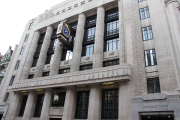Media
-
 Donald Trump sues BBC for £7.5bn over edited January 6 speech
Donald Trump has launched a £7.5 billion lawsuit against the BBC, accusing the public broadcaster of defamation and deceptive editing in a documentary examining the January 6, 2021, attack16 December 2025Read More...
Donald Trump sues BBC for £7.5bn over edited January 6 speech
Donald Trump has launched a £7.5 billion lawsuit against the BBC, accusing the public broadcaster of defamation and deceptive editing in a documentary examining the January 6, 2021, attack16 December 2025Read More... -
 Daily Mail owner agrees £500m deal to acquire Telegraph titles
The publisher of the Daily Mail has struck a £500 million agreement to buy the Telegraph newspapers, bringing an end to months of uncertainty over the titles’ future ownership.22 November 2025Read More...
Daily Mail owner agrees £500m deal to acquire Telegraph titles
The publisher of the Daily Mail has struck a £500 million agreement to buy the Telegraph newspapers, bringing an end to months of uncertainty over the titles’ future ownership.22 November 2025Read More... -
 BBC reports £1.1bn loss as licence fee income falls amid viewer exodus
The BBC has recorded a £1.1 billion loss as growing numbers of viewers either cancel or fail to pay the TV licence fee, according to a new parliamentary report.21 November 2025Read More...
BBC reports £1.1bn loss as licence fee income falls amid viewer exodus
The BBC has recorded a £1.1 billion loss as growing numbers of viewers either cancel or fail to pay the TV licence fee, according to a new parliamentary report.21 November 2025Read More... -
 Trump says he still plans to sue BBC, despite its apology
Donald Trump says he’s moving forward with legal action against the BBC next week, even though the broadcaster has already apologised for misleadingly editing one of his speeches.15 November 2025Read More...
Trump says he still plans to sue BBC, despite its apology
Donald Trump says he’s moving forward with legal action against the BBC next week, even though the broadcaster has already apologised for misleadingly editing one of his speeches.15 November 2025Read More... -
 BBC apologises to Trump for edited Panorama clip — but says it won’t pay damages
The BBC has apologised to US President Donald Trump after a Panorama episode stitched together parts of his 6 January 2021 speech in a way that could imply he was directly calling for14 November 2025Read More...
BBC apologises to Trump for edited Panorama clip — but says it won’t pay damages
The BBC has apologised to US President Donald Trump after a Panorama episode stitched together parts of his 6 January 2021 speech in a way that could imply he was directly calling for14 November 2025Read More...

Culture
-
 IWM Duxford to open new Second World War rooms revealing unseen artefacts and daily life of wartime pilots
IWM Duxford is set to open three newly restored Second World War spaces, offering visitors an intimate look at the lives of aircrew stationed at the Cambridgeshire airfield during the conflict.Read More...
IWM Duxford to open new Second World War rooms revealing unseen artefacts and daily life of wartime pilots
IWM Duxford is set to open three newly restored Second World War spaces, offering visitors an intimate look at the lives of aircrew stationed at the Cambridgeshire airfield during the conflict.Read More... -
 War-torn Trafalgar Union Flag faces possible departure from UK
A rare Union Flag that led the British charge at the Battle of Trafalgar has been placed under an export bar, giving UK institutions the chance to keep the historic relic in the country.Read More...
War-torn Trafalgar Union Flag faces possible departure from UK
A rare Union Flag that led the British charge at the Battle of Trafalgar has been placed under an export bar, giving UK institutions the chance to keep the historic relic in the country.Read More... -
 Barbican to host Liam Young’s first UK solo exhibition in 2026
The Barbican has announced ‘In Other Worlds’, the first UK solo exhibition by artist, director and BAFTA-nominated producer Liam Young. Opening May 2026, the immersive show will exploreRead More...
Barbican to host Liam Young’s first UK solo exhibition in 2026
The Barbican has announced ‘In Other Worlds’, the first UK solo exhibition by artist, director and BAFTA-nominated producer Liam Young. Opening May 2026, the immersive show will exploreRead More... -
 The Manchester Museum displays thousands of African artefacts it knows little about
A museum in northwest England has unveiled a new gallery showcasing thousands of African artefacts, many of which the institution admits it knows very little about. The exhibition aims toRead More...
The Manchester Museum displays thousands of African artefacts it knows little about
A museum in northwest England has unveiled a new gallery showcasing thousands of African artefacts, many of which the institution admits it knows very little about. The exhibition aims toRead More... -
 Captain John Narbrough’s journal faces export ban amid fears it could leave the UK
A rare 17th-century manuscript journal documenting Captain John Narbrough’s secret expedition to Spanish America and the Pacific has been placed under a temporary export ban, giving UKRead More...
Captain John Narbrough’s journal faces export ban amid fears it could leave the UK
A rare 17th-century manuscript journal documenting Captain John Narbrough’s secret expedition to Spanish America and the Pacific has been placed under a temporary export ban, giving UKRead More... -
 Earliest evidence of human fire-making unearthed in Suffolk
A team led by the British Museum has uncovered what is now the earliest known evidence of humans deliberately making fire—dating back around 400,000 years—at a site in Barnham,Read More...
Earliest evidence of human fire-making unearthed in Suffolk
A team led by the British Museum has uncovered what is now the earliest known evidence of humans deliberately making fire—dating back around 400,000 years—at a site in Barnham,Read More... -
 Rothschild 15th-century prayer book set to fetch up to $7 million at Sotheby’s auction
Ultra-rare 15th-century mahzor features vivid medieval illustrationsRead More...
Rothschild 15th-century prayer book set to fetch up to $7 million at Sotheby’s auction
Ultra-rare 15th-century mahzor features vivid medieval illustrationsRead More... -
 Ray Winstone honoured with Freedom of the City of London
Ray Winstone, one of the UK’s most celebrated ‘hard man’ actors, has been awarded the Freedom of the City of London in recognition of his extensive charitable and fundraising work.Read More...
Ray Winstone honoured with Freedom of the City of London
Ray Winstone, one of the UK’s most celebrated ‘hard man’ actors, has been awarded the Freedom of the City of London in recognition of his extensive charitable and fundraising work.Read More... -
 Golden Globe 2026 nominations announced ahead of January ceremony
The nominations for the 83rd annual Golden Globe Awards were unveiled on Monday, setting the stage for the first major awards ceremony of the season on January 11.Read More...
Golden Globe 2026 nominations announced ahead of January ceremony
The nominations for the 83rd annual Golden Globe Awards were unveiled on Monday, setting the stage for the first major awards ceremony of the season on January 11.Read More... -
 Mayor of London granted right to use historic GLC coat of arms
The Mayor of London has been officially granted permission to use the historic coat of arms once belonging to the former Greater London Council (GLC), following approval from the King.Read More...
Mayor of London granted right to use historic GLC coat of arms
The Mayor of London has been officially granted permission to use the historic coat of arms once belonging to the former Greater London Council (GLC), following approval from the King.Read More... -
 Who will shape the National Gallery’s tomorrow? Architects shortlisted for landmark expansion
The National Gallery has announced a shortlist of six architectural teams competing to design a major new wing as part of its ambitious £750 million Project DomaniRead More...
Who will shape the National Gallery’s tomorrow? Architects shortlisted for landmark expansion
The National Gallery has announced a shortlist of six architectural teams competing to design a major new wing as part of its ambitious £750 million Project DomaniRead More... -
 National Gallery unveils ambitious exhibition programme for 2026
The National Gallery has announced a landmark line-up of exhibitions for 2026, spanning five centuries of European art and bringing together rare loans, first-ever UK presentations, and iconicRead More...
National Gallery unveils ambitious exhibition programme for 2026
The National Gallery has announced a landmark line-up of exhibitions for 2026, spanning five centuries of European art and bringing together rare loans, first-ever UK presentations, and iconicRead More...

British Queen celebrates
Most Read
- Teen held after US woman killed in London stabbings
- Heave-ho Harry! Prince prepares to join the walking wounded in ice trek to North Pole
- Football: Farhad Moshiri adamant Everton deal above board
- "Master of English Style". Interview with Designer Lydia Dart
- Letter to the Financial Times from Lord Mayor Alderman Michael Bear
Culture

HarperCollins, the publishing house that handles the rights to Agatha Christie's books, has edited several of her novels to remove potentially offensive language, including references to ethnicity

British actor and UNICEF goodwill ambassador Orlando Bloom recently visited Ukraine for three days to meet with families and children affected by Vladimir Putin's ongoing invasion. During his

After 47 years in the industry, Britain's longest-serving newsreader, Alastair Stewart, has announced his retirement from regular broadcasting. The 70-year-old journalist has worked as a news

London's West End was adorned with 30,000 lights for the first time in history to mark the beginning of Ramadan. Coventry Street, which connects Leicester Square to Piccadilly, was

In London, it rains. Lots. Indeed, even in the late spring. Additionally, it may be quite chilly. As a result, Londoners are often looking for interesting places to hide from the elements. Therefore,

More than 70 cultural organisations across the country are to be given a financial boost by the government so they can improve people’s access to arts, support local economic growth through

The London Transport Museum has announced that bookings are now open for this year's exclusive Hidden London tours, which provide access to locations that are normally off-limits to the

The London Borough of Croydon has announced a year-long programme of music and art events as part of its designation as London Borough of Culture for 2023. The events, which will run

New research has revealed that Leonardo da Vinci, renowned artist of the Renaissance and painter of the 'Mona Lisa,' was only half-Italian, as his mother was a slave from the Caucasus.

London's luxury retail industry is concerned that the city is losing its allure as a shopping destination. Tourists from the United States, China, and the Gulf are flocking to Paris and Milan where






















